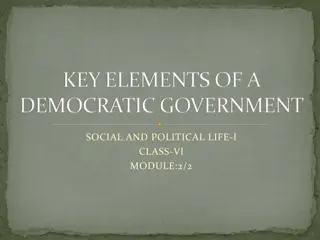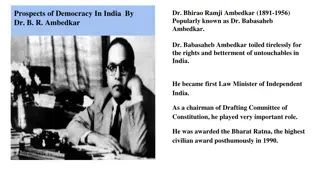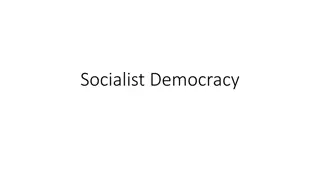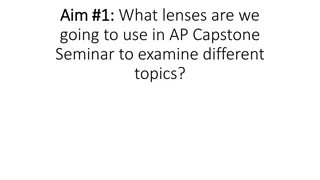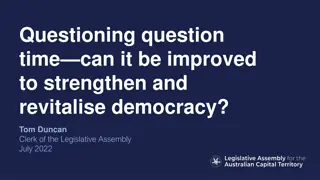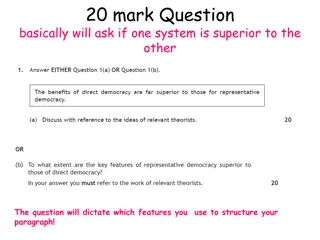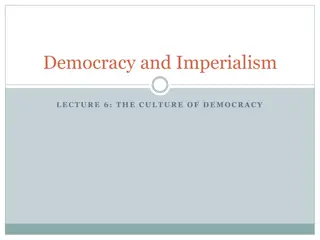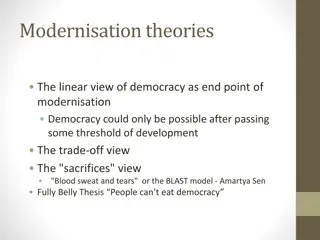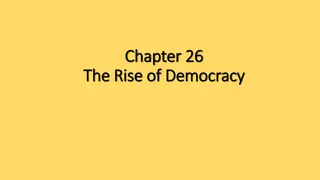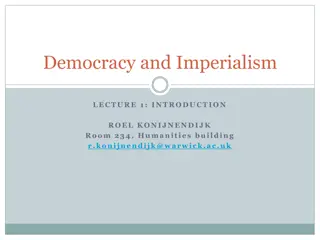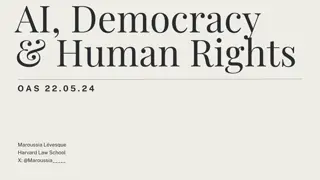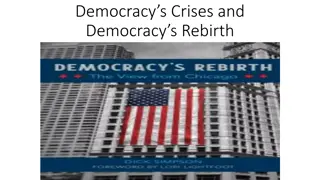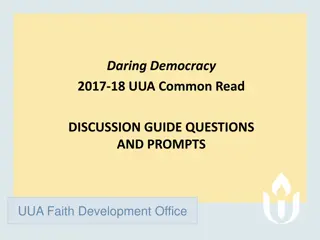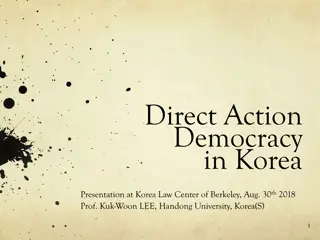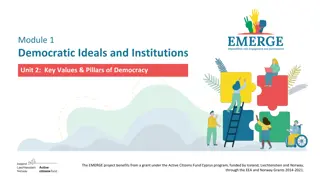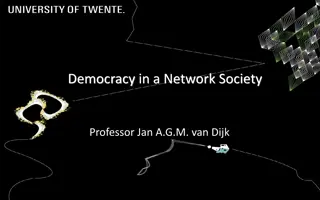Exploring Democracy, Government Ideals, and Global Impact: A Comprehensive Analysis
Delve into the roots of American democracy, government ideals, and political scenarios in the Middle East and North Africa. Analyze the impact of the Arab Spring, U.S. responses, and Trump's immigration ban within the region. Reflect on governmental structures, revolutions, and foreign policy implications.
Download Presentation

Please find below an Image/Link to download the presentation.
The content on the website is provided AS IS for your information and personal use only. It may not be sold, licensed, or shared on other websites without obtaining consent from the author. Download presentation by click this link. If you encounter any issues during the download, it is possible that the publisher has removed the file from their server.
E N D
Presentation Transcript
BRAINSTORMING What would you say is the best thing about our government and our country? What ideals is our government based upon? Where did many of these ideals come from? How are our governmental ideals different from other countries around the world? HINT: THINK ABOUT THE MIDDLE EAST
MAP OF THE MIDDLE EAST AND NORTH AFRICA: 2011 Countries in Orange: Free Countries in Red: Partly Free Countries in Purple: Not Free
RETAINING PRIOR KNOWLEDGE What do you already know about these Middle Eastern and North African countries? What type of governments do you think they have? What do you know about the political stability in the region? How are these governments different than the US government
THE ARAB SPRING- 2011 https://www.youtube.com/watch?v=tqOdG9RygNw https://www.youtube.com/watch?v=lGGDfmhKoyk How does the video clip explain the spread of these revolutions? Do you think this political climate is a good or bad thing for the United States? What should be the US foreign policy towards countries in this region? What impact are these revolutions having in Europe?
JOURNAL 3: THE ARAB SPRING IN SYRIA AND US RESPONSE Read the article on The Arab Spring in Syria and the US Response and answer these questions in your Journal Section: 1. What were the Syrian people protesting against? What kind of government does Syria have? Who has the power in this government? 2. What kinds of countries and groups got involved in the fighting in Syria and why did they get involved? 3. What event started The Arab Spring in Syria? 4. What was Trump s original stance towards the Syrian conflict? 5. Why was Trump at first worried to target the Assad regime in Syria? 6. What actions did Trump take in Syria from 2017-2018? Do you believe he did the right thing? Why or why not?
TRUMPS BAN ON IMMIGRATION -Trump banned immigration from Iran, Iraq, Libya, Somalia, Sudan, Syria and Yemen -US District Judge Robart reversed the ban -Protests held all over the world against Trump s Ban -US Department of Justice filed an appeal on the ban: supported Trump -US Court of appeals denied the appeal: went against Trump -12/4/2017: US Supreme Court reinstates Trump s Ban
RED=COUNTRIES THAT IMMIGRATION WAS BANNED FROM YELLOW= ONLY PEOPLE WITH BUSINESS TIES CAN COME
ANALYZING TRUMPS BAN ON IMMIGRATION Why do you think Trump picked the countries that he did to ban immigration from? What are pros of banning immigration from these countries? What are cons of banning immigration from these countries? Do you think it is right that a District Judge can overturn a Presidential Order? Where is Congress in this whole issue? Do you think the founding principles of our government are being shown in the modern day?
WARM UP Who was John Locke and what ideas did he come up with that were integrated into the US government?
REMINDER: COMMUNITY SERVICE PROJECT Due Date: April 15th Worth 200 points
HOMEWORK: COLONIAL AMERICA MAP Create a map of the thirteen colonies and label each colony Color code them to show which colonies were in New England, the Middle Colonies, and the Southern colonies Do some research and list three facts about each colony
LEARNING OBJECTIVES Analyze the basic concepts of government in Colonial America Interpret what England was like when the Magna Carta was signed Synthesize the three landmark English documents
BRAINSTORMING-WHERE DID WE GET THE FOUNDATIONS FOR OUR GOVERNMENT? What country did we get the majority of our ideas about government from? Why this country? Did another country/civilization influence the governmental ideas of this country? How so? Which country/civilization do you think has been most influential on governments throughout history?
CONCEPTS OF GOVERNMENT IN COLONIAL AMERICA -Ordered Government: English settlers wanted to have regulations on their relationships with one another, so they formed local governments -Limited Government: English settlers DIDN T believe that the government could do whatever it wanted -Representative Government: English settlers believed that the government should serve the will of the people
CHECK FOR UNDERSTANDING Which concept do you think was most important for the English colonists? Which concept do you think is most evident in modern American government? Which concept do you think is the least evident in modern American government? What do you know about English history that might have led to these conceptions of government that the English colonists brought over to the Thirteen Colonies (documents, ideas, people, wars, etc.)
ROBIN HOOD: FICTIONAL CHARACTER BASED ON TRUTH https://www.youtube.com/watch?v=if34bKbBqXI What does Robin Hood want the King to do? What kinds of ideals does Robin Hood want the King to uphold? Robin Hood says he s been everywhere from Palestine, to France, and back why would an English soldier during this time have done so much traveling? Can you think of other fairy tales that might be based on real historical events?
FAIRY TALES BASED ON TRUTH http://www.huffingtonpost.com/valerie-ogden/fairy-tale-true- story_b_6102602.html Snow White and the Seven Dwarves: Rapunzel Hansel and Gretel The Pied Piper Cinderella
IRONCLAD- KING JOHN AND THE MAGNA CARTA https://www.youtube.com/watch?v=h5czM9pf9Wo How would you describe England during this time period based on the depiction in this scene? How would you describe King John based on this depiction? Do you think this is an accurate depiction? Why or why not? Which of the four political theories on where the state came from is John using to justify his crown? What are the King and the Baron arguing about? What does the conflict revolve around? Based on their argument what do you think the Magna Carta is?
LANDMARK ENGLISH DOCUMENTS The Magna Carta (1215): Included fundamental rights such as trial by jury, due process of law, and everyone is entitled to life, liberty and property Petition of Right (1628): Limited king s power by saying that he couldn t imprison/punish anyone without judgement of his peers, no martial law in times of peace, and no sheltering of troops without consent from homeowner Bill of Rights (1689): Prevented abuse of power by monarchs through ensuring that there was no army during peace time, all parliamentary elections are free, right to a fair trial, and freedom from cruel and unusual punishment
INTERESTING FACT Instead of signing his name on the Magna Carta, King John put his seal can you guess why???
CHECK FOR UNDERSTANDING Which of these documents do you think was most significant to the foundation of the American Government? Which of these documents do you think best represents Ordered Government? Which of these documents do you think best represents Limited Government? Which of these documents do you think best represents Representative Government?
CREATE YOUR OWN TIMELINE BY LABELING THE FOLLOWING EVENTS 1215: King John signs The Magna Carta 1337-1453: The Hundred Years War- England vs. France 1625: Charles 1 takes power in England 1628: Charles I signs the Petition of Rights 1629: Charles I ignores the Petition of Rights and rules without Parliament 1642-1651: English Civil War- Parliamentary forces led by Oliver Cromwell vs. Royalists led by Charles I 1688: William and Mary take the throne of England 1689: Signing of the English Bill of Rights
GALLERY WALK: ANALYZING PICTURES Walk around and analyze the different pictures that are throughout the room For each picture, answer the questions below the picture RECORD ANSWERS ON YOUR OWN PAPER-NOT ON THE IMAGE Above your answer, be sure to label the title of the images you are analyzing
DRAW YOUR OWN PICTURE Under each event that you labeled on the timeline, draw your own picture that shows how you view each event
WARM UP Identify three governmental ideas that the English colonists came to America with and explain why they had developed these ideas, based on your knowledge of English history
HOMEWORK: COLONIAL AMERICA MAP Create a map of the thirteen colonies and label each colony Color code them to show which colonies were in New England, the Middle Colonies, and the Southern colonies Do some research and list three facts about each colony
LOOKING AHEAD BRING TEXTBOOKS NEXT CLASS: THIS WILL BE GRADED
LEARNING OBJECTIVES Interpret the English Bill of Rights Analyze the three types of colonial governments Synthesize Early Attempts at Unification in the US
JOURNAL 4-THE ENGLISH BILL OF RIGHTS Read through the primary source on the English Bill of Rights and then answer these questions in your Journal Section Who was ruling England when the English Bill of Rights was signed? How did they come to power? 1. Who was ruling England before these people? According to the Bill of Rights, identify five things that he did wrong 2. What ideals for the English government were laid out in the Bill of Rights? Identify five things 3. Which of these ideals do we see in the foundations of the American Government? 4. What ideals are not in the American government which were written in the English Bill of Rights (think religious/military)? 5.
RETAINING INFORMATION Can you name all the original thirteen colonies? What was the first settlement in the thirteen colonies called? What country had colonies to the north and what country had colonies to the south? What reasons did people have for coming to the thirteen colonies? What were the demographics of the thirteen colonies like? How were the thirteen colonies divided up?
THE THIRTEEN COLONIES: BEFORE AND AFTER THE FRENCH AND INDIAN WAR
ROOTS OF AMERICAN DEMOCRACY VOCABULARY Rule of Law: No one is above the law Individual Rights: Rights and liberties that can be claimed by any human Separation of Powers: Idea that the powers of government should be split between two or more strongly independent branches Popular Sovereignty: Principle that people are the ultimate source of authority and legitimacy Constitutionalism: Belief that governments should operate in accordance with written down principles Majority Rule: The idea that decisions approved by more than half of the people in a group or society will be accepted and observed by all others
CHECK FOR UNDERSTANDING Why do you think these concepts and ideas were so important to the English colonists when they came to the US? Do you believe that our modern day government is upholding these principles and ideals? Why or why not? Do you truly believe that the people are the ones with legitimacy and authority, not the government? Which of these vocabulary terms do you believe is most important to you? Why? Why is it important for a government to have written down principles? What pros and cons can you think of for majority rule?
TRANSITIONING TOWARDS INDEPENDENCE I will no longer be the leader of this class You will be responsible for everyone learning, teaching the material, creating your own Class Norms, and ensuring the class runs smoothly How will you do this? Write out a plan (1 paragraph) on how the class will now be run. You can have one teacher, multiple teachers, no teachers, etc. Then, once everyone has written their plan out, we will get into groups, and each group will choose someone s plan, and your group will demonstrate how the class will now run, according to that plan
CHECK FOR UNDERSTANDING Who would the teacher have represented in that activity in the government of Colonial America? How did this activity demonstrate the situation that the colonies faced when they declared independence from Britain? What document claimed that the Thirteen Colonies were forming their own nation and were now an independent country? What do you think is the most important thing for people of a new country to focus on when creating their government?
WARM UP What does transition mean? Give an example of a time when you went through a transition? Were you immediately successful in this transition or did you have some setbacks?
HOMEWORK Complete Study Guide for Test on Power, Politics, and Government and Roots of American Democracy
LOOKING AHEAD Test Next Week
LEARNING OBJECTIVES Analyze Early Attempts at Unification in the United States Interpret the American Road to Independence Engage in Collaborative Learning
EARLY ATTEMPTS AT UNIFICATION New England Confederation (1643): Settlers in New England came together to protect against Native Americans Albany Plan of Union (1754): Benjamin Franklin s plan to form an annual congress of delegates from each of the Thirteen Colonies 1. Delegates- Representatives Stamp Act Congress (1765): A statement of grievances formed by the delegates of the colonies that was sent to the King in an attempt to show oppose British taxes and policies
CHECK FOR UNDERSTANDING Based on what you know about British history, why couldn t the British protect the colonists in New England from Native Americans? Which of these early attempts at unification was the most important? Why do you think this? What war led to the British having to raise taxes and pass overbearing laws on the colonists, such as the Stamp Act? What other taxes and overbearing laws were passed that led to the American Revolution?
ROAD TO REVOLUTION: BRITISH ANGER THE AMERICANS https://www.youtube.com/watch?v=9ShwJesWLBI -What was the Proclamation Act of 1763? -What kinds of things did the British put taxes on? -What happened in Boston in response to these taxes in 1770? -Why did the Intolerable Acts do and why did the British pass them? -What did the fight revolve around? (Think back to Economics) -Why do you think it says its far from over at the end of the clip?
TEXTBOOK WORK: CHAPTER 3, SECTION 3, PAGES 42-45 Read pages 42-45, starting at From Ideas to Independence - The Decision to Declare Independence
CREATE A TIMELINE: TAXES AND OVERBEARING LAWS ON THE AMERICAN COLONISTS After you have labeled each event, draw a graphic that shows the perspective of the American colonists on each law/tax -1754-1763: French and Indian War -1767: Townshend Act -1765: Stamp Act -1765: The Quartering Act -1770: Boston Massacre -1773: The Tea Act leads to Boston Tea Party -1774: The Intolerable Acts- Britain takes control of Mass. and takes over the port of Boston
CHECK FOR UNDERSTANDING Which early attempt at unification in the thirteen colonies do you think was most significant? Why do you think this?
FIRST AND SECOND CONTINENTAL CONGRESS First Continental Congress(1774): Grouping of many of the Founding Fathers of America in which they protested the acts/laws/taxes passed against the colonies, urged for colonies to stop trade with Britain, and called for the creation of local committees in the colonies Second Continental Congress(1775-1781): First national American government that led America through the Revolutionary War and appointed John Hancock as president and George Washington was put in charge of the army


